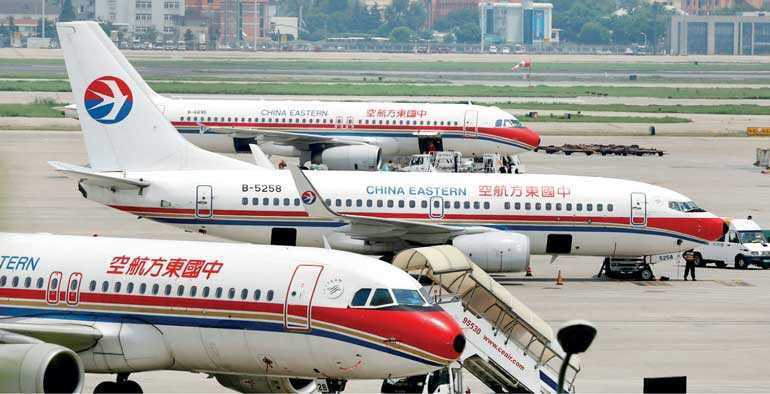Monday Apr 07, 2025
Monday Apr 07, 2025
Monday, 23 March 2020 00:01 - - {{hitsCtrl.values.hits}}

Every airline in the world is reeling. Even the privately owned and hitherto most profitable carriers that had been expected to withstand the shock, are rushing to their national governments for assistance.
The world has belatedly woken up to the consequences of the COVID-19 (coronavirus) pandemic now upon us.
No precedents
The first column that raised awareness of this issue was written in early February. At that time, I anticipated that the impact would be much worse than the SARS epidemic, with airline losses estimated to be in the region of $ 20-25 billion. This has since proven to be laughably optimistic; in the final analysis, actual losses could run into over a trillion dollars.
Airlines
Every airline in the world is reeling. Even the privately owned and hitherto most profitable carriers that had been expected to withstand the shock, are rushing to their national governments for assistance. Inevitably, their strident, impassioned pleas for support will claim that the airline industry is “strategic”, “vital” and “irreplaceable”.
The International Air Transport Association (IATA) has bluntly stated that losses will run into hundreds of billions, and that by the end of May 2020, most airlines will be “functionally bankrupt”.
Some regional differences are clear:
North America
The Big Three (American, Delta and United) are healthy, though American must be bitterly regretting the ‘share buyback’, costing $ 5 billion in cash, which the airline could have used now. Southwest Airlines, Alaska Airlines, and JetBlue are also in a sufficiently comfortable financial position to be able to weather a long downturn. The domestic markets that all of them rely on should come back to life in two to three months, if the Chinese experience translates.
North of the border, Air Canada should survive too. WestJet, a smaller Low-Cost Carrier (LCC), has announced a complete stoppage of flights from next week; but it too will probably endure. For all the other smaller carriers, however, this is probably the end of the runway.
The super-connectors
A pandemic strikes hard at the heart of the ‘hub and spoke’ business plan that relies on building a huge airport and moving millions of people through it.
Their rivals have long accused super-connectors Turkish Airlines, Qatar Airways, Emirates, and Etihad Airways of dumping capacity and pushing down revenues. COVID-19 will hit them very hard. Qatar has already ceased flying, and walled off the country to everyone but its own nationals. As the world’s wealthiest country (per capita), Qatar can afford to wait out COVID-19 and try to exploit the surge of travel that will ultimately result.
Turkey does not publicize the extent of the pandemic within its boundaries, but given its proximity to Iran (which is badly affected by the coronavirus), and with the world’s largest refugee population, chances are that the pandemic will cause havoc there.
Emirates Airlines has been caught out with probably the worst mix of aircraft in its fleet. Most airlines have stopped flying the giant Airbus A380, but Emirates, with in excess of a hundred of the type in its inventory, has little choice but to continue. They seem to be hoping to fill the niche as many rivals cease flights altogether.
Etihad was already in dire financial straits, and tumbling oil prices will mean that the government of the UAE (owner of both Etihad and Emirates) will not have the petro-dollars to tide them over. A merger between the two giants and flydubai (a LCC owned by the government) is probably the best solution.
Europe
The stronger European LCCs, such as Ryanair, easyJet, and Wizz Air, have acted fast. Most of their aircraft are idle as they concentrate on reducing costs and hoarding cash.
The healthier European full-service airlines such as British Airways, Air France-KLM and Lufthansa will eventually prevail, though if COVID-19 is as bad in the rest of Europe as it is in Italy, recovery may be very painful.
Australia and Oceania
Qantas celebrates its 100th anniversary this year, joining an elite club of airlines of approximately the same age, the others being KLM, Avianca, and British Airways. A lavish event had been planned to celebrate the centenary of the ‘Flying Kangaroo’, but COVID-19 has put a damper on that, with Qantas struggling to survive. All its wide-bodied aircraft (A380s, Boeing 747-400s and Airbus A330s) have been grounded; only the Boeing 787 Dreamliner is connecting Australia to the world, but this too is scheduled to cease next week. Separately, Qantas domestic traffic continues, but not at the levels of only a few weeks ago.
Virgin Australia has ceased all international flights, and is only operating on domestic routes. Having lost money for several years, VA is in poor financial shape and may not survive this crisis unless the Australian government steps in.
Across the Tasman Sea, Air New Zealand is in better shape financially, although overly dependent on international traffic. With ‘The Land of the Long White Cloud’ effectively cordoned off, ANZ will have to be rescued by the government, which owns 52% of the carrier.
China
As is widely known, the pandemic began in China, and to date that nation has borne the brunt of airline ‘pain’. But the country appears to be recovering, and flights have restarted, albeit slowly. The Chinese national government owns the three huge airlines – Air China, China Eastern and China Southern – so they will continue to be funded. But it is unlikely that the trio will return to their former glory for many years.
The smaller Chinese carriers (and there were many), which are either owned by provincial governments or private, will probably never recover. There will almost certainly be a spate of mergers and consolidations.
Asia
Most of Asia’s carriers, with the exception of a handful, are government-owned unprofitable dinosaurs. They are, in the dismissive words of Peter Harbison, the Chairman of the CAPA (Centre for Asia Pacific Aviation): “…almost a pyramid-selling scheme. In many cases, such carriers have little cash of their own, flying planes owned by aircraft leasing companies. In such cases, when cash stops coming in the door, there are few or no owned assets that can be used as collateral for new loans and the carriers collapse financially in a matter of weeks.”
Almost all Asian carriers were very dependent on China, and even profitable, well-managed outfits such as Cathay Pacific, Singapore Airlines, Korean Air, and Japan Airlines, may well become victims of COVID-19.
Without massive bailouts, most of Asia’s flag carriers such as Air India, Thai, Malaysian, Garuda Indonesia etc, are insolvent already. Yet, with the health of its citizens and the country’s defence highest on the list of any government’s priorities, it is both a moot point and fascinating dilemma as to whether national governments can continue to afford the luxury of propping up the airline industry.
Discover Kapruka, the leading online shopping platform in Sri Lanka, where you can conveniently send Gifts and Flowers to your loved ones for any event including Valentine ’s Day. Explore a wide range of popular Shopping Categories on Kapruka, including Toys, Groceries, Electronics, Birthday Cakes, Fruits, Chocolates, Flower Bouquets, Clothing, Watches, Lingerie, Gift Sets and Jewellery. Also if you’re interested in selling with Kapruka, Partner Central by Kapruka is the best solution to start with. Moreover, through Kapruka Global Shop, you can also enjoy the convenience of purchasing products from renowned platforms like Amazon and eBay and have them delivered to Sri Lanka.
Discover Kapruka, the leading online shopping platform in Sri Lanka, where you can conveniently send Gifts and Flowers to your loved ones for any event including Valentine ’s Day. Explore a wide range of popular Shopping Categories on Kapruka, including Toys, Groceries, Electronics, Birthday Cakes, Fruits, Chocolates, Flower Bouquets, Clothing, Watches, Lingerie, Gift Sets and Jewellery. Also if you’re interested in selling with Kapruka, Partner Central by Kapruka is the best solution to start with. Moreover, through Kapruka Global Shop, you can also enjoy the convenience of purchasing products from renowned platforms like Amazon and eBay and have them delivered to Sri Lanka.